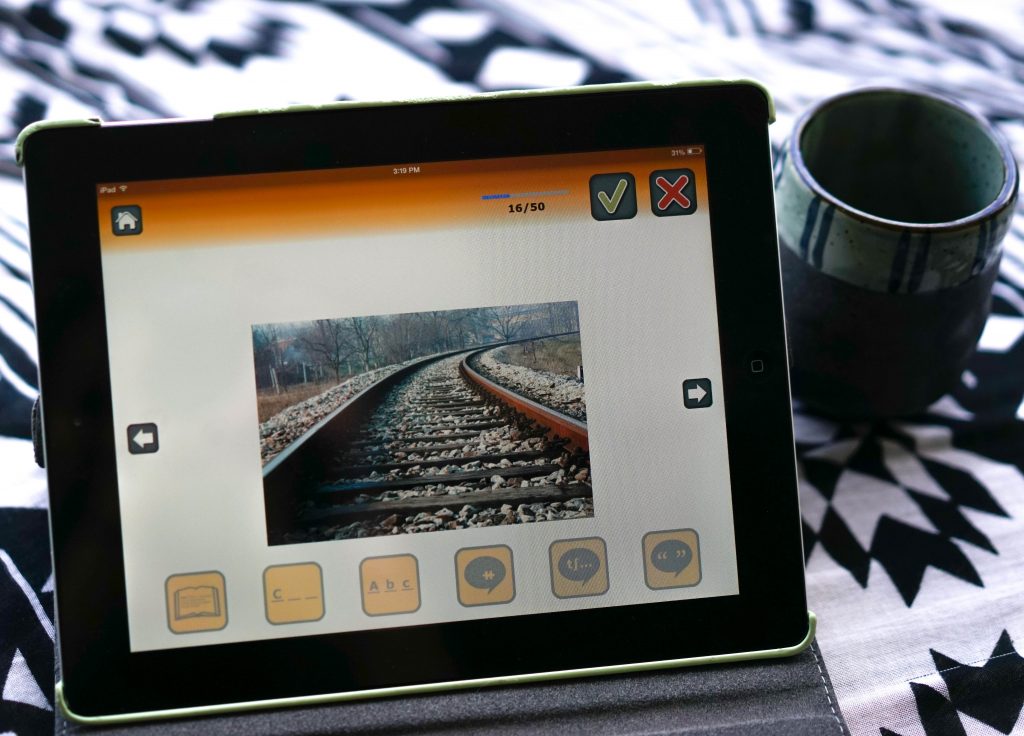As a speech-language pathologist who travels to different facilities for work, I never know what therapy materials may be available at my next building. I also don’t want to burden myself by traveling with a lot of materials. Or, spending a lot of money on materials. Thus, I’ve become an expert in doing more with less when it comes to speech therapy materials for adults.
I have a couple of “go to” cognitive communication materials that I travel with that have served me extremely well with the adult rehab population. As a minimalist, I don’t think that we need a lot of materials and that we can do more with less.
What are the patient’s goals?
Before discussing therapy materials, it’s important to consider what are the patient’s goals. What do they want to achieve in their speech therapy sessions and why are they there? Their goals will drive how you develop your plan of care and what materials you are going to use. One reason I feel so confident about being a minimalistic materials therapist is because in order for patients to achieve their goals, they often need to be functional and motivating. That functionality and motivation doesn’t come from endless hours of workbooks or sequencing cards, but from activities and items surrounding them. As a clinician, be creative to find functional tasks and materials in their environment that you can use during sessions.
5 Speech Therapy Materials for Adults:
1. Tablet with apps
A tablet (iPad, etc) with access to apps and an internet browser can provide endless speech therapy materials for adults. Tablets are also an extremely functional-based therapy. Most people need to use their tablet or computer to stay connected in this digital age and consume information.
There are endless possibilities to use a tablet in speech therapy sessions. Knowing what your patient’s goals are can help you determine what to do during your sessions. If a patient loves to travel and has higher level deficits, you might have them search for flights and vacation itineraries on Google.
Apps designed specifically for speech therapy materials for adults can assist in cognitive and communication therapy. For language and aphasia treatments, I like Language Therapy: Tactus Therapy Solutions App called Language Therapy – 4-in-1 Toolkit for Aphasia. This app really comes in clutch because they have a photo card library of hundreds of up-to-date photos. No more digging through the therapy office to find photo cards that may or may not be 40 years old when you have this app.
Other functional ways to use a tablet in adult speech therapy:
- Calculator for math tasks
- Searching Craigslist/FB Marketplace to purchase items
- Looking up the weather forecast for the week and the best days to do outdoor activities
- Using maps to find directions from one location to another
- Searching YouTube for funny videos to watch
- Anything and everything else that could be functional towards your patient’s goals
- Searching for top news stories and having your patient summarize them
- Finding scores of sports games
2. Patient’s cell phone
Similar to a tablet, it’s extremely functional and goal-oriented to work with the patient’s own cell phone. Cell phones are a huge part of communication in society. Having a stroke or brain injury that affects the ability to communicate will likely affect use of a cell phone to communicate with their network.
Many times, patients will tell me their frustrations with using the phone without me even asking. E.g. difficulty sending texts, verbally talking over the phone, or responding over social media messages. As a speech therapist, you can not only work to improve those areas of communication, but also teach compensatory strategies. For example, if a patient is having difficulty writing/typing, but is speaking clearly, you can teach compensation with voice messages or text-to-speech while working with spelling and writing.

3. Pen and paper
If one thing feels like holding a safety blanket as an adult SLP, it’s walking into a room with an extra pen and sheets of paper. Pen and paper is crucial if you need to provide written and visual information during sessions. It also allows your patient to write or use drawings as a compensatory language strategy.
4. Copies of your favorite workbook pages
One of the reasons why you might be searching for speech therapy materials is because you’ve noticed that “speech therapy workbooks” tend to be outdated and to be honest, kinda boring. While I’ve used workbooks a lot in the past as a novice clinician, I’ve moved away from them as I’ve matured clinically. However, that doesn’t mean there aren’t good workbook pages out there.
As a minimalist SLP, I keep PDF copies of my favorite workbooks/pages on my Google Drive and can print them as needed at my jobs. I also throw the directions on the pages to the wind when using workbooks and use them in different ways.
For example, the Walc 1 Aphasia Rehab has pages in their first unit that are meant for symbol matching for patients with severe auditory comprehension deficits. However, I love to use those pages with brain injury patients who have left-neglect and severe attention issues. I use a highlighter as a visual anchor to draw the patient’s attention to the left as we are working on a left neglect task. There are creative ways to let the workbook pages work for you and your patients goals.
5. Deck of Cards
A deck of cards is cheap, easy to carry and makes great speech therapy materials for adults of all levels. You can use a deck of cards to address basic attention tasks, sequencing, left neglect, and complex tasks. You can combine memory, executive functioning, and problem solving by playing games like Gin Rummy, Hearts, and Spades.
To get more ideas on how to use a deck of cards in therapy, check out this article.

Conclusions
Speech therapy materials for adults do not have to clutter your office or car. They can be simple, small, functional materials that provide goal-driven outcomes. You can do a lot with a little if you keep your patient’s functional goals at the forefront of your therapy and use your own creativity and imagination.
Read more for SLPs:
- How to Make 100k as an SLP
- 3 Website to Find Affordable ASHA Ethics CEUs
- How to Become a Travel SLP
- Sample SLP Interview Questions

I also have the Lingraphica Aphasia apps on my phone and ipad to allow for easy access and assessment of abilities to use an AAC.
Awesome!! 🙂
Question what apps are you using to assess AAC abilities.? I am just curious and would like to try this app.
If I’m trying to fit somebody with a specific device I would order a loaner for a month of the device and track progress with the specific device. I don’t love any of the adult AAC apps out there now. Lingraphica has some that can be helpful.
I love the WALC books, but they are starting to get outdated. Anyone know if there is anything similar, but more updated?
I agree! HoneyComb Speech has some really good modern materials. https://honeycombspeechtherapy.com/